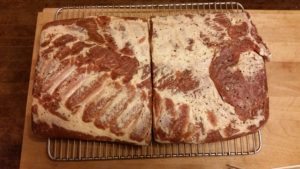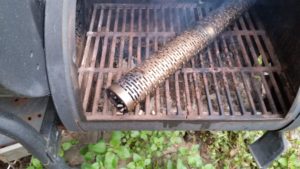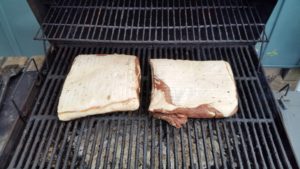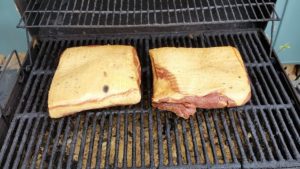Some of the links below are affiliate links, meaning, at no additional cost to you, I will earn a commission if you click through and make a purchase.
As I mentioned in my last post, I had some bacon curing in the fridge. I took it out of the cure last night so it could air dry, and today it got smoked. Let’s take a look at the process.
Procuring a Pork Belly
I’ve often said that this is the hardest part of the whole process. If you’re a farmer raising pigs, you’re set. The rest of us, however, face the challenge of finding a good butcher who’s willing to part with a precious belly, before making bacon of his own. (They’re “precious” because there’s only one per pig; maybe 15-20 pounds for a good-sized full belly.)
I’ve had luck in the past at my local Costco; they occasionally have raw pork belly out (sold in half-bellies, typically 8-10 pounds each). But more often, and much more reliably, I head to my local ethnic grocery. In my local area, we have G-Mart and H-Mart; both are full-sized grocery stores, catering to Latin American and Oriental cuisines. Since pork belly is fairly common in Chinese cooking (as a soup flavoring), they typically have it in stock. If you don’t see it out front, ask the butcher behind the counter.
Preparation
Preparing the belly is optional, and will partly depend on how you get it. I like boneless, skinless bellies, because most of the work has been done for me, and I’m left paying for just the “bacon part,” by weight.
If you got it skin-on, don’t worry; you can leave it on, and remove it after smoking. (Save it for cracklings, or soup additives.) If you got bone-in pork belly, you’ll want to remove the bones (ribs) with as little mangling as possible.
After that, I generally cut the belly into two parts, across the center of the belly to give me two rough squares to work with. This isn’t absolutely necessary, but it makes the meat easier to handle. They also fit nicely into extra-large (~2.5 gallon) Ziploc bags.
Into the Cure
I use a variation of the basic bacon cure from Ruhlman and Polcyn’s book Charcuterie: for about every 5 pounds of pork, use 2 ounces (50g) kosher salt, 12g pink salt, 1/4 cup dark brown sugar, 1/4 cup maple syrup, and a healthy dash of fresh, coarsely ground black pepper.
(I apologize for the mixture of measures; between cooking, brewing, and various other hobbies, I move back and forth between systems pretty smoothly. Generally, if it’s important that I get a specific amount by weight or volume, I’ll go metric; if it’s safe to fly by the seat of your pants, I’m fine with Imperial measures.)
Some folks take issue with the use of “pink salt” (AKA “Prague Powder” or “curing salt”, and which adds sodium nitrite to the mix) for health reasons. I counter with the fact that the human body produces sodium nitrite as part of the digestive process, anyway. And besides, if I was being that health-conscious, I wouldn’t be making and eating bacon, right?
Anyway, I put each of the chunks of pork belly into a Ziploc bag, and add a dose of the cure to each bag. Then I zip the bags shut, squeezing out as much air as possible. Then I massage the cure components as thoroughly as I can, over the entirety of the pieces of meat. then, into the refrigerator they go!
Waiting Game
The curing bellies sit in the refrigerator for 5-7 days. (The original recipe calls for a week, but I find that the meat cures faster without the skin, so I lean more towards 5 days.) Flip them over at least daily, and make sure to re-distribute the brine which forms in the bags across the meat.
By the end of the curing process, the meat will be significantly firmer than when you started. The “lean” parts will have darkened somewhat, and the whole thing should look something like this:
Smoke, but no Fire
At this point, the bacon is technically ready to cook and eat. Just heat it in the oven, with as low a heat as you can get, until it reaches an internal temperature of 150 degrees; let it cool a bit, and slice off the skin with a sharp knife.
Or, you can go the route I much prefer, and smoke it. Ruhlman and Polcyn call for a hot-smoke, about 3 hours, ending the same as with the oven method. I like to cold-smoke it, though.
Until I get a full smoker built (a project for another time), I use my grill, and a nifty pellet smoking tube I found. It uses pellets for the smoke, which is convenient: you can find dozens of types of pellets online for use in smoking, and they’re inexpensive, take up less room than chunks of wood, and work extremely well. I find that with the tube, I can easily get six to eight hours of consistent smoke.
It uses pellets for the smoke, which is convenient: you can find dozens of types of pellets online for use in smoking, and they’re inexpensive, take up less room than chunks of wood, and work extremely well. I find that with the tube, I can easily get six to eight hours of consistent smoke.
This batch of bacon is getting an apple-maple mix that I’ve found to be quite lovely. Other good choices for this bacon would have been oak or maybe cherry; I wouldn’t go for anything heavier like hickory or mesquite, though, as they’d be a bit much for the cure.
It’s Bacon!
Here’s the slabs before and after smoking:


The last step in the process, unless you’re going to immediately fry it all up and eat it, is to separate it into “single-meal portions,” then wrap it and freeze it (I like vacuum-sealing it). For slabs like this (about 4.5 pounds each), I’ll cut each into rough thirds. Make sure to cut across the grain of the meat, otherwise the bacon can be stringy.
I’ll probably do another couple of slabs of bacon over the fall and winter; I’d also like to do some bigger “whole-muscle” cured bits, like bresaola, lonzo, and maybe a dry-cured pork shoulder (“almost” prosciutto). Heck, I’d like to do a prosciutto, as well as a country-style ham. But before I do either of those, I’ll need to work on that smokehouse project, to say nothing of becoming good friends with one of the local butchers.
What do you think, readers? Do you have suggestions for other curing mixes, or for other things to cure? (I often put some cheese on the top rack in the grill and smoke it, when I’m doing something like this.) Let us know in the comments!
